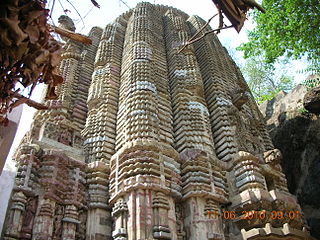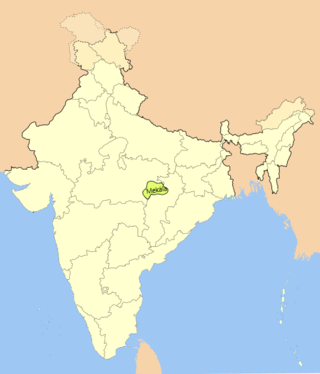Related Research Articles

Kosala, sometimes referred to as Uttara Kosala was one of the Mahajanapadas of ancient India. It emerged as a small state during the Late Vedic period and became one of the earliest states to transition from a lineage-based society to a monarchy. By the 6th century BCE, it had consolidated into one of the four great powers of ancient northern India, along with Magadha, Vatsa, and Avanti.

The Vakataka dynasty was an ancient Indian dynasty that originated from the Deccan in the mid-3rd century CE. Their state is believed to have extended from the southern edges of Malwa and Gujarat in the north to the Tungabhadra River in the south as well as from the Arabian Sea in the west to the edges of Chhattisgarh in the east. They were the most important successors of the Satavahanas in the Deccan and contemporaneous with the Guptas in northern India.

Dakshina Kosala is a historical region of central India. It was located in what is now Madhya Pradesh and Chhattisgarh along with parts of Western Odisha. At its greatest extent, it may have also included a part of the Vidarbha region in present-day Maharashtra.

Bargarh District is an administrative district of Odisha state in eastern India. The city of Bargarh is its district headquarters. The district was carved out of the erstwhile district of Sambalpur on 1 April 1993.

The history of Odisha begins in the Lower Paleolithic era, as Acheulian tools dating to the period have been discovered in various places in the region. The early history of Odisha can be traced back to writings found in ancient texts like the Mahabharata, Maha Govinda Sutta and some Puranas. The region was also known to other kingdoms in region of East Indies due to maritime trade relations.
Chandradeva, also known as Chandraditya, was an Indian king from the Gahadavala dynasty. He ruled the Antarvedi country in present-day Uttar Pradesh, including Kanyakubja and Varanasi.

The Kalachuris of Ratnapura, also known as the Haihayas of Ratanpur, were a dynasty that ruled in Central India during the 12th and 13th centuries. They ruled parts of present-day Chhattisgarh from their capital at Ratnapura. They were an offshoot of the Kalachuris of Tripuri, and ruled as vassals of the parent dynasty for many years.

The Later Gupta dynasty, also known as the Later Guptas of Magadha, were the rulers of Magadha and Malwa from the 6th to 8th centuries CE. The Later Guptas emerged after the disintegration of the Imperial Guptas as the rulers of Magadha and Malwa however, there is no evidence to connect the two dynasties and the Later Guptas may have adopted the -gupta suffix to link themselves the Imperial Guptas.

The Sharabhapuriya dynasty ruled parts of present-day Chhattisgarh and Odisha in India, during 5th and 6th centuries. The dynasty probably served as Gupta vassals in their early days, but became practically independent as the Gupta empire declined. The Sharabhapuriyas were succeeded by the Panduvamshis. The dynasty is known mainly from its copper-plate inscriptions, and a few coins.
The Somavamshi or Keshari dynasty ruled parts of present-day Odisha in eastern India between the 9th and the 12th centuries. Their capitals included Yayatinagara and Abhinava-Yayatinagara.

Sirpur Group of Monuments are an archaeological and tourism site containing Hindu, Jain and Buddhist monuments from the 5th to 12th centuries in Mahasamund district of the state of Chhattisgarh, India. Located near an eponymous village, it is 78 kilometres (48 mi) east of Raipur, the capital of the state. The site is spread near the banks of the river Mahanadi.
The Panduvamshis or Pandavas were an Indian dynasty that ruled the historical Mekala region in present-day Chhattisgarh state of India, during the 6th and the 7th centuries. The Panduvamshi kings, who were Shaivites, claimed descent from the legendary Pandavas and also claimed to be members of the lunar dynasty. They may have been Gupta feudatories, and may have been related to the Panduvamshis of Dakshina Kosala, but this cannot be said with certainty.
The Panduvamshis or Pandavas were an Indian dynasty that ruled the historical Dakshina Kosala region in present-day Chhattisgarh state of India, during the 7th and the 8th centuries. They may have been related to the earlier Panduvamshis of Mekala: both dynasties claimed lunar lineage and descent from the legendary Pandavas.

Mahendra was a king of Dakshina Kosala, whose identity is not completely verified, and is mentioned as a king of Dakshinapatha or Southern India. He was one of the many kings who were subjugated, captured and later released by the powerful Gupta emperor Samudragupta on his Dakshinapatha campaign. Mahendra of Kosala was one of the southern kings of Dakshinapatha paying allegiance and tribute to Samudragupta. His dynasty is uncertain, though some historians suggest that he was from the Kosala branch of the Mahameghavahana dynasty. This branch of the Mahameghavahana dynasty is often identified with the Meghas of Kosala, who ruled over Kosala from the 3rd century AD to the 6th century AD.
Maha-Shivagupta Balarjuna alias Shivagupta was the greatest and most powerful king of the Panduvamshi dynasty of Dakshina Kosala. Under him, Sirpur witnessed incredible growth in cultural and political activities.

The Varman dynasty was a dynasty that ruled the Kingdom of Kannauj from the mid 7th century to the late 8th century. It was founded by Yashovarman, who filled the power vacuum created after emperor Harshavardhana's death.
Rajarsitulyakula was a royal house that controlled Dakshina Kosala in India. They were also known as the Sura dynasty and were succeeded by the Parvatadvarkas.

The Chindaka Nagas were a dynasty that ruled over parts of modern-day Odisha and Chhattisgarh. Their kingdom was known as Chakrakota mandala and included the present-day districts of Bastar, Koraput and Kalahandi. They were constantly at war with their neighbours- the Somavamshi dynasty, the Kalachuris of Ratnapura, the Mana dynasty and the Western Chalukya Empire.
Trikalinga is a historical region of central-east India, mentioned in several historical sources. Its identification and its relation to the term "Kalinga" is debated among modern historians, who variously identify it as a distinct region to the west of Kalinga, a larger region comprising Kalinga and two other regions, a constituent of the greater Kalinga, or the three divisions of Kalinga proper.

Mekala is a historical region of India, extending from Amarkantak to Balaghat. It corresponds to the Maikal Hills, which comprises the present-day Kawardha District of Chhattisgarh state and Anuppur district of Madhya Pradesh. In the medieval period, the region was ruled by the Panduvamshis of Mekala.
References
- ↑ "Laxman Temple Sirpur". Yatra. Yatra. Retrieved 29 December 2020.
- 1 2 "Laxman Temple, Sirpur, history, Timings, Entry fee". Gosahin. Gosahin. Retrieved 29 December 2020.
- ↑ A. M. Shastri I 1995, p. 168.
- ↑ A. M. Shastri I 1995, p. 169.
- ↑ A. M. Shastri I 1995, p. 161.
- ↑ "Sirpur- An Icon of Dakshina-Kosala: Indian History and Architecture". Puratattva. Puratattva. Archived from the original on 2022-02-13. Retrieved 2020-12-29.
Works cited
- Ajaya Mitra Shastri (1995). Inscriptions of the Śarabhapurīyas, Pāṇḍuvaṁśins, and Somavaṁśins: Part I. Motilal Banarsidass. ISBN 978-81-208-0635-1.